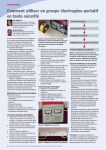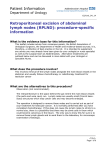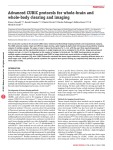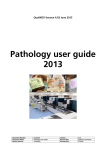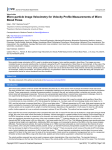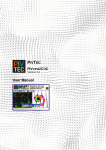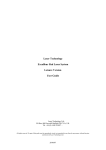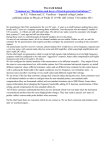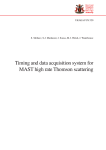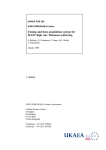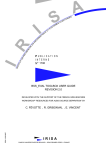Download Laser Safety Officer: - Department of Engineering
Transcript
Local Laser Rules Local Rules for the Use of the PIV and Sizing Apparatus Location: Hydraulics Laboratory, Inglis building, CUED main site, Trumpington Street Cambridge. Laser Safety Officer: Dr Tim Wilkinson CUED Tel: 01223 339709 Email: [email protected] Laser protection advice available from: Lisabeth Yates Health & Safety Division Tel: 01223 766354 Email: [email protected] Issued under the authority of: Version and Date: Version 001 – 01/02/2005 Scope These local rules cover the use of the Particle Image Velocimetry (PIV) systems located at present in the Hydraulics laboratory. They cover the set-up and alignment of the laser as well as the normal use of the apparatus. They implement the University’s laser safety policy at a practical level and form part of the University’s duties under Section 2(3) of the Health & Safety at Work Act 1974. Description The PIV systems permit the direct measurement of particle velocity and size by capturing images of particles suspended in a flow and illuminated with a sheet of laser light. There are two systems both with the same operating principles but with different specifications. The low-speed system uses a twin-head 120 mJ 532 nm NdYAG laser to illuminate the flow field and captures images at around 3 Hz. The high speed system uses a 10 mJ 532 nm Nd-YAG laser to illuminate the flow-field at speeds up to 2000 Hz. Both systems use cameras to view the illuminated particles. Both systems are enclosed in a laser enclosure during use which consists of a large box enclosing the flow region of interest and has interlocked doors so that the user does not have access to the laser emissions. By pulsing the laser, two images can be taken in quick succession and the data manipulated to gather the required velocity- field information. In the PIV configuration, the laser is positioned perpendicularly to the camera and laser optics are employed to convert the raw beam into a diverging laser sheet, with which to bisect the particle stream. Authorised Users Only persons who have been adequately trained by a qualified member of either Dantec or LaVision (the respective suppliers or a trained member of the fluids group, and are listed as an authorised user in the appendix to these local rules, may operate and/or carry out maintenance on the PIV apparatus. Training The training provided by the suppliers is comprehensive and covers all aspects of both the PIV systems as well as the relevant Health & Safety issues. This training was provided in the form of a one-off demonstration of the apparatus. Given this situation, all subsequent training will be provided by Tim Nickels, who was present at the initial training session, and as such is a qualified user. The content of any training should include: • • • • • • • General Health & Safety training for the laboratory (Risk Assessment). Specific Health & Safety training regarding Laser Radiation (Local Rules). Precise description of the system arrangement for both PIV and Sizing. Description of the required cable connections for both PIV and Sizing. Description of the correct operating procedures to follow during lasing. Description of both the PIV and Sizing software packages. Precise description of the procedures to be followed during shutdown. Laser Controlled Area Due to the size of the flow apparatus, the Laser Controlled Area has been designated as the area surrounded the water channel. This area is controlled by signs and by user vigilance. Both systems are enclosed in a laser enclosure during use which consists of a large box enclosing the flow region of interest and has interlocked doors so that the user does not have access to the laser emissions, with key control to the laser itself which shuts off the power supply and emissions. In addition to this, a warning beacon – mounted on the outside of the enclosure – is illuminated during laser operation. There are signs displayed adjacent to the beacon, warning of laser light (starburst) and a Class IV laser product in use. There are also mobile chain barriers with warning signs placed at the entrances to the area used when the laser is in operation (warning that the laser is in use). Procedures The main procedures that will be carried out with regard to the setup and maintenance of the PIV systems are outlined below. The first section concerns setup for normal operation, with the procedures listed in the sequence that they should be performed. The second section concerns maintenance, giving approximate timescales for each procedure and exactly who is responsible/permitted to execute the task. Normal Operation 1. The shutting of all doors of the enclosure which automatically connects the interlock jacks to close the laser interlock circuit. 2. The manual switching of the warning beacon to indicate the operation of the laser. 3. The connection of the laser and cameras to the laser PSU, synchronising equipment and the local computer. 4. The checking of the laser PSU for sufficient cooling water and performing refill if necessary. 5. The physical arrangement of the laser and cameras in preparation for imaging. 6. The alignment of the laser and cameras such that clear images are obtained. 7. The synchronisation of the laser and cameras to ensure a laser pulse is contained within each camera image/exposure. 8. The process of firing the laser and taking images. Maintenance • • • The cooling-water filter should be replaced every six months by a trained user. The laser heads should be re-aligned annually by a qualified Oxford Lasers' service engineer. Electrical safety checks should be performed annually by University-trained personnel. Protection Measures As stated in the risk assessment, there are certain procedures required for the safe use and maintenance of the PIV and Sizing apparatus which must be followed at all times, these include: • • • • Before use, all users must be suitably trained and have attended the University's laser safety course. Before use, all visitors must be made aware of the local laser rules and laboratory regulations. Before use, all doors on the enclosures must be closed and the interlocks connected to the laser PSU. Before use, the laser-safety warning beacon must be switched on. This beacon must also be switched off after use. • • • • • • • Before use, all reflective jewellery (watches, rings etc.) must be removed and stowed in a remote location. Before use, it must be ensured that all lights in the laboratory are switched on. Key control must be practiced at all times. This may only be performed by authorised users, with the keys stored in the designated key cupboard. When connecting the equipment together, all cables must be carefully laid out and tidied away as best as possible, with cable gullies used where appropriate. When re-filling the cooling water reservoir, care must be taken to ensure it is correctly sealed. During setup, all equipment must be secured to the mounting rails/platforms provided. If the laser beam is not enclosed within the filtered chamber (i.e. during alignment and maintenance) due care and attention must be paid to the local safety rules and risk assessment. For further information please see the appropriate user manual.s. Summary of Hazards A full description of the hazards that may be encountered whilst operating the PIV systems can be found in the corresponding risk assessment document, which is located in the appendix. However the following information provides a summary of those hazards: • • • • • • • Direct laser radiation as well as diffuse and specular reflections for a Class IV laser are hazardous and may result in ocular damage, specifically photochemical and thermal retinal injury, and/or skin damage including skin darkening and photosensitive reactions. Potential electric shock hazard from the high voltage laser PSU. Any Class IV laser product is a potential fire hazard. Potential fire/electric shock hazard as a result of a cooling water spillage/leak. If the correct key control is not implemented then there is the possibility that an untrained user could activate the laser. The potential consequences of this scenario include ocular/skin damage, fire and electric shock hazards etc. Cables and connectors lying across the laboratory present a possible trip hazard leading to potential bodily harm and/or equipment damage and system downtime. The use of a pulsed laser may present a risk to epileptics. Contingency Plan In the event of an incident/accident the following procedures should be followed: 1. THINK!!! The environment may still be hazardous - Exposure to direct Class IV laser radiation and even diffuse/specular reflections can be hazardous to both the eyes and skin, resulting in photochemical and thermal retinal injury, and skin darkening and photosensitive reactions. 2. If there is a suspected eye injury, contact the local first aid officer and/or seek medical advice. 3. Contact one of the following people: • Dr Tim Wilkinson, CUED Laser Safety Officer, tel: 01223 339709. • Prof Nick Collings, Local Safety Officer, tel: 01223 741847. 4. Isolate any equipment pending investigation. If ocular exposure has occurred, a thorough investigation into the cause and nature of the exposure must take place and the findings recorded. 5. If there is a suspected injury to the eye, consult Occupational Health if possible who will make an assessment and arrange an urgent referral as appropriate. 6. If there is a suspected injury to the eye, consult Occupational Health if possible who will make an assessment and arrange an urgent referral as appropriate. 7. If an injury is confirmed, the injured person should see a specialist ophthalmologist preferably within 24 hours of the injury occurring. The injured person must not drive. 8. If the accident occurs outside the normal working hours of Occupational Health, the injured person should attend the nearest Accident and Emergency (Addenbrookes Hospital). Addenbrookes has an eye clinic where a specialist ophthalmologist should be available for consultation. However, if an ophthalmologist is not available within 24 hours of the injury occurring, you should then be referred to the nearest specialist eye hospital, Moorfields, which has experience in dealing with laser eye injuries. 9. In some circumstances the casualty may benefit from reassurance and professional counseling. If in doubt attend the nearest Accident and Emergency (Addenbrookes Hospital). 10. Details of the laser beam should accompany the casualty to hospital, i.e. wavelength, power/energy per pulse and pulse duration. Addenbrookes Hospital: Accident and Emergency Department open 24 hours a day. Address: Hills Road, Cambridge CB2 2QQ UK Telephone: 01223 245 151 Moorfields Eye Hospital Accident and Emergency Department open 24 hours a day. Address: 162 City Road, London EC1V 2PD Telephone: 020 7253 3411 Location and directions to the A&E department can be found at the website: www.moorfields.co.uk/Locations/CityRoad Appendix Authorised Users: Cambridge Engineering Department User Declaration I have read, understood and agree to work by the rules set out in this document. Review Date This is a working document and as such should be frequently updated, however as a control measure, this document should be reviewed on or before 11/11/2005.






